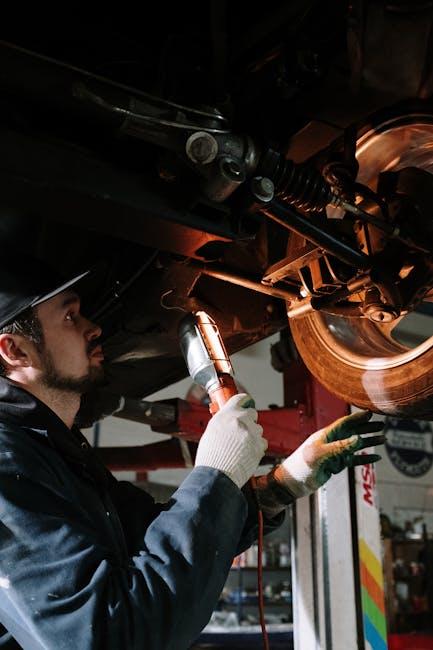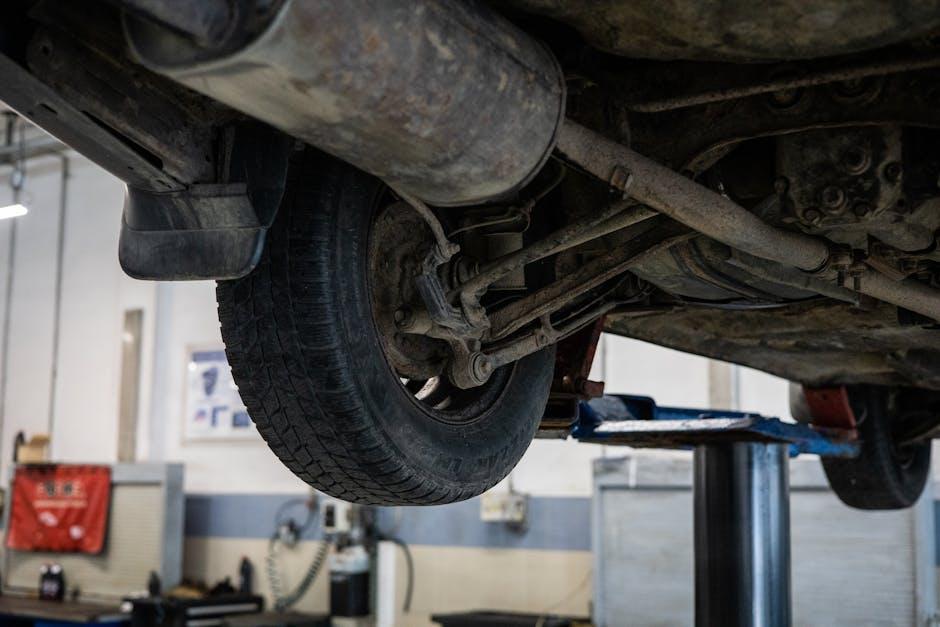Your car’s suspension is the unsung hero of every smooth drive, quietly absorbing bumps and keeping you connected to the road. But how often do we stop to check if it’s still up to the task? Understanding the health of your suspension system isn’t just for mechanics—it’s something you can do yourself, right in your driveway. In this article, we’ll walk you through simple, practical steps to inspect your car’s suspension at home, helping you spot potential issues before they turn into costly repairs or safety hazards. Whether you’re a seasoned gearhead or a casual driver, a little knowledge can go a long way in keeping your ride comfortable and secure.
Table of Contents
- Understanding the Role of Your Car’s Suspension System
- Identifying Common Suspension Issues Before They Escalate
- Tools You Need for an Effective Home Suspension Inspection
- Step by Step Guide to Checking Shock Absorbers and Struts
- Evaluating Suspension Springs and Bushings for Wear and Tear
- When to Consult a Professional After Your Home Inspection
- Q&A
- Concluding Remarks

Understanding the Role of Your Car’s Suspension System
Your car’s suspension system is far more than just springs and shocks; it plays a crucial role in maintaining vehicle stability, comfort, and safety. This intricate network works tirelessly to absorb bumps and vibrations, ensuring tires maintain contact with the road for optimal control. By dampening impacts, it not only cushions you from harsh road conditions but also supports braking and steering responsiveness. Neglecting suspension health might lead to uneven tire wear, reduced fuel efficiency, and compromised handling, ultimately affecting your driving experience and safety.
Recognizing the signs of suspension wear early can save you significant repair costs down the road. Watch out for symptoms like:
- Excessive bouncing after hitting a bump
- Uneven tire tread patterns
- Pulling to one side while driving
- Clunking or rattling noises from the wheel area
Performing simple checks at home can give you insights into which components may need attention. Testing each wheel’s rebound or visual inspection under the car for leaks or broken parts can provide valuable clues before seeking professional help.

Identifying Common Suspension Issues Before They Escalate
Catch early signs before costly repairs become inevitable by regularly checking your suspension system. Look out for uneven tire wear, which often signals misalignment or failing shocks. When parked, gently push down on each corner of the car—if it bounces more than once or twice, your shocks or struts may be wearing out. Listen closely for unusual noises such as clunks or creaks when driving over bumps; these can indicate loose or broken suspension components.
Here are some common warning signs to watch for:
- Pulling to one side: This can mean uneven tire pressure or damaged suspension parts.
- Vibrations in the steering wheel: Often caused by worn-out suspension bushings or ball joints.
- Excessive body roll: Noticeable sway during turns suggests weakened stabilizer bars or springs.
- Visible leaks: Oil stains near shock absorbers often mean they’re compromised.
| Symptom | Likely Cause | Urgency |
|---|---|---|
| Uneven tire wear | Misaligned suspension | Medium |
| Clunking noises | Loose ball joints | High |
| Car pulling | Damaged shocks | Medium |
| Oil leaks near struts | Worn shocks | High |

Tools You Need for an Effective Home Suspension Inspection
Before diving into the suspension inspection, gathering the right tools ensures the process is smooth and effective. A solid car jack and sturdy jack stands are essential for safely lifting and securing your vehicle. You’ll also want a good quality flashlight to spot wear and tear in dimly lit areas, and a pry bar or long screwdriver can help test for play in suspension joints. Don’t overlook a tire pressure gauge—properly inflated tires can make it easier to identify suspension issues by noting differences in ride height or tire wear patterns.
For a thorough check, keep handy:
- Car jack and jack stands: Crucial for lifting the vehicle.
- Flashlight: For visibility in tight spaces.
- Pry bar or screwdriver: To test suspension joint movement.
- Tire pressure gauge: To check for uneven tire inflation.
- Measuring tape: Useful for comparing ride height on both sides.
| Tool | Purpose |
|---|---|
| Car Jack | Lift vehicle safely |
| Jack Stands | Support vehicle securely |
| Flashlight | Illuminate dark areas |
| Pry Bar | Test joint play |
| Tire Pressure Gauge | Check tire inflation |

Step by Step Guide to Checking Shock Absorbers and Struts
Begin by locating the shock absorbers and struts, which are typically found near each wheel, connecting the wheel assembly to the vehicle’s frame. Start your visual inspection by checking for any signs of damage, such as dents, oil leaks, or rust on the shock absorber body. Holding the vehicle steady, push down firmly on one corner of the car and release; the suspension should bounce back smoothly and settle quickly. Excessive bouncing or unusual noises indicate worn shocks or struts. Remember, each wheel deserves this test for a thorough evaluation.
Next, perform a hands-on check for play or looseness. Grasp the shock absorber near its mounts and try to wiggle it gently—any excessive movement or knocking sounds can reveal a failing component. For a deeper analysis, observe the tire wear pattern; uneven or cupped tread often signals suspension issues. Use the table below to quickly interpret different symptoms and their possible causes:
| Symptom | Possible Cause |
|---|---|
| Oil on Shock Body | Seal Leak, Worn Shock |
| Excessive Bouncing | Weak or Broken Strut |
| Uneven Tire Wear | Suspension Misalignment |
| Clunking Noise | Loose Mounts or Bushings |

Evaluating Suspension Springs and Bushings for Wear and Tear
Start by visually inspecting the suspension springs for any signs of damage like cracks, rust, or sagging. A healthy spring maintains a steady, even shape without any discoloration or corrosion. If your car feels unusually low or bounces excessively after pressing down on the hood or trunk, this could point to a weakened or broken spring. Be sure to check both sides, as uneven spring wear can cause instability while driving.
Next, examine the bushings—the small rubber cushions that absorb shocks and reduce vibrations. Look for cracks, brittleness, or signs of oil contamination, which can degrade their performance. You can also use a pry bar to gently apply pressure around each bushing; excessive movement or looseness often signals the need for replacement. Here’s a quick checklist to guide you:
- Visual cracks or tears in rubber components
- Oil stains or leaks near bushings
- Uneven wear on springs
- Excessive bounce or sway when pressing the car body
| Component | Common Signs of Wear | Impact on Driving |
|---|---|---|
| Suspension Springs | Rust, sagging, cracks | Reduced stability, noisy ride |
| Bushings | Cracks, brittleness, oil damage | Vibrations, poor handling |

When to Consult a Professional After Your Home Inspection
After performing your suspension check, it’s crucial to recognize the signs that indicate a professional’s expertise is needed. If you notice uneven tire wear patterns, persistent clunking noises while driving, or your vehicle pulls sharply to one side even after adjusting the alignment, these are red flags. Such issues often hint at deeper mechanical problems beyond simple DIY fixes, warranting a thorough examination by a qualified mechanic.
Additionally, if your visual inspection reveals damage like cracked bushings, leaking shock absorbers, or bent control arms, it’s a strong indicator to seek help. Attempting to repair or replace complex suspension components without proper equipment and experience may lead to unsafe driving conditions or costly mistakes. Use the checklist below to decide whether to call in a professional:
- Suspension sagging or uneven vehicle height
- Visible oil leaks from shocks or struts
- Excessive bouncing after hitting a bump
- Steering wheel vibration or wobble
- Noticeable knocking or rattling noises
Q&A
Q: Why is it important to check my car’s suspension regularly?
A: Your car’s suspension system plays a crucial role in ensuring a smooth ride, maintaining tire contact with the road, and providing safe handling. Regular checks can help you catch issues early, preventing costly repairs and enhancing driving safety.
Q: What tools do I need to check my car’s suspension at home?
A: You’ll need a flashlight, a jack and jack stands (or sturdy ramps), a measuring tape or ruler, and some basic wrenches. Additionally, having gloves and a helper can make the process easier and safer.
Q: What signs should I look for when inspecting the suspension?
A: Look for uneven tire wear, visible damage or leaks in shock absorbers or struts, unusual noises like clunks or squeaks while driving, and excessive bouncing after pressing down on the car’s corners.
Q: How do I perform a simple bounce test on my car?
A: Press down firmly on one corner of your car, then release. The car should bounce up once and settle immediately. If it continues bouncing multiple times, it indicates worn shocks or struts that may need replacement.
Q: How can I check for leaks in my suspension system?
A: Shine the flashlight on the shock absorbers or struts. Look closely for oily or greasy residue, which often signals a leaking shock absorber that’s losing its damping ability.
Q: What should I do if I notice uneven tire wear?
A: Uneven tire wear might suggest alignment problems or worn suspension components like ball joints or bushings. It’s best to have a professional perform a complete inspection and alignment check if you notice this.
Q: Is it safe to check suspension components myself?
A: Yes, as long as you take safety precautions—use jack stands rather than just a jack, work on a flat surface, and wear proper safety gear. If you feel unsure at any point, consulting a professional mechanic is wise.
Q: Can I replace suspension parts myself if I find problems?
A: Some suspension parts are doable for DIY enthusiasts with mechanical skills, but others require specialized tools and knowledge. Consider your expertise level before attempting repairs; safety comes first.
Q: How often should I check my car’s suspension?
A: Aim to inspect your suspension at least twice a year or whenever you notice any unusual symptoms like handling issues, noises, or tire wear patterns.
Q: What’s the takeaway from checking suspension at home?
A: Regular at-home suspension checks empower you to spot potential issues early, keep your ride smooth and safe, and save money by addressing minor problems before they escalate. It’s a simple habit that benefits both your car and your peace of mind.
Concluding Remarks
Checking your car’s suspension at home might seem like a small task, but it’s a crucial step in maintaining a smooth, safe ride. With a bit of patience and the right approach, you can catch early warning signs before they turn into costly repairs. Remember, your suspension is the silent guardian beneath your wheels, absorbing bumps and keeping you grounded. So, take the time to give it a thorough once-over—your car, and your peace of mind, will thank you. Safe driving starts with a confident suspension!


4 Comments
dgdsx2
dgdsx2
5af3x3
5af3x3